THE ORGANIZATIONAL BEHAVIOUR
VerifiedAdded on 2022/08/22
|11
|2853
|13
AI Summary
Contribute Materials
Your contribution can guide someone’s learning journey. Share your
documents today.
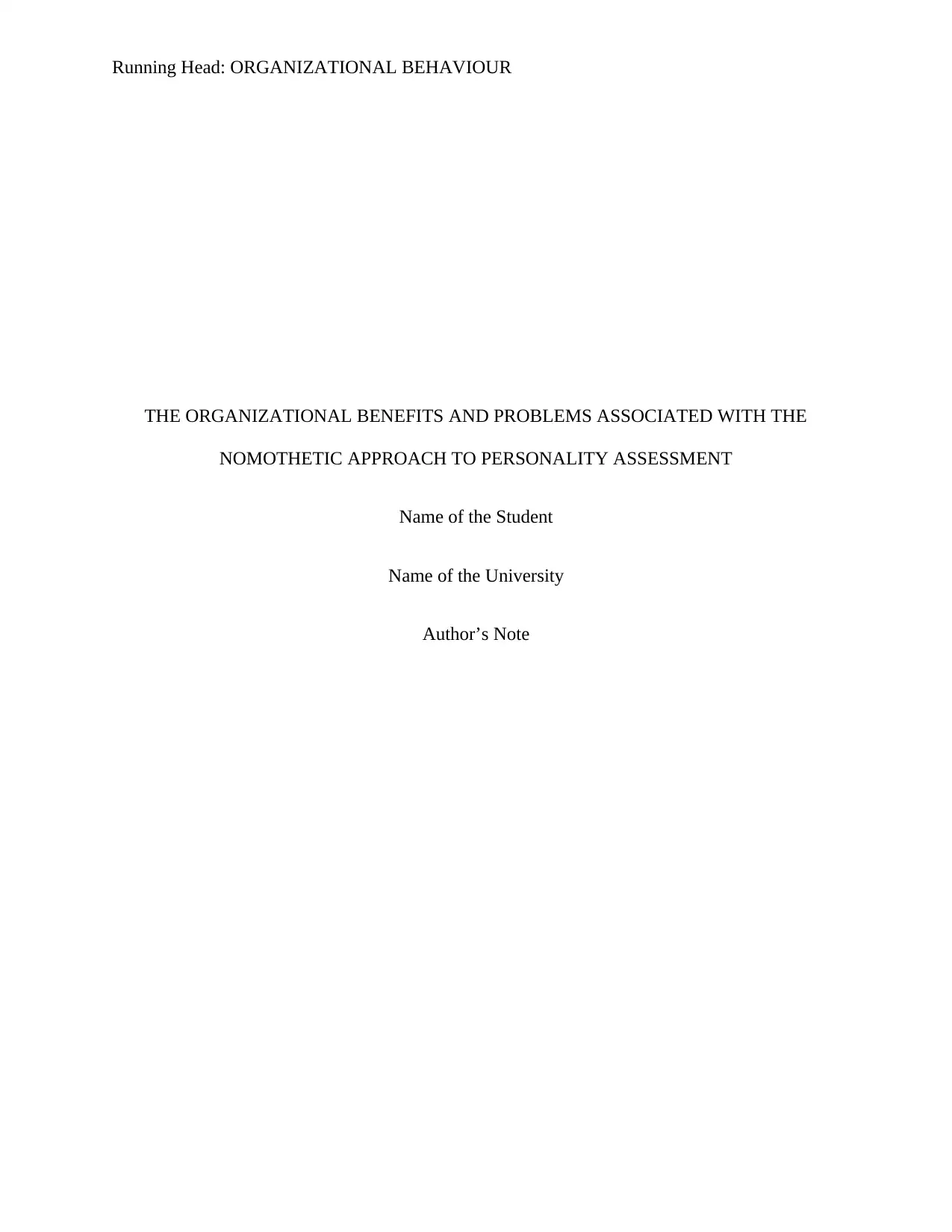
Running Head: ORGANIZATIONAL BEHAVIOUR
THE ORGANIZATIONAL BENEFITS AND PROBLEMS ASSOCIATED WITH THE
NOMOTHETIC APPROACH TO PERSONALITY ASSESSMENT
Name of the Student
Name of the University
Author’s Note
THE ORGANIZATIONAL BENEFITS AND PROBLEMS ASSOCIATED WITH THE
NOMOTHETIC APPROACH TO PERSONALITY ASSESSMENT
Name of the Student
Name of the University
Author’s Note
Secure Best Marks with AI Grader
Need help grading? Try our AI Grader for instant feedback on your assignments.
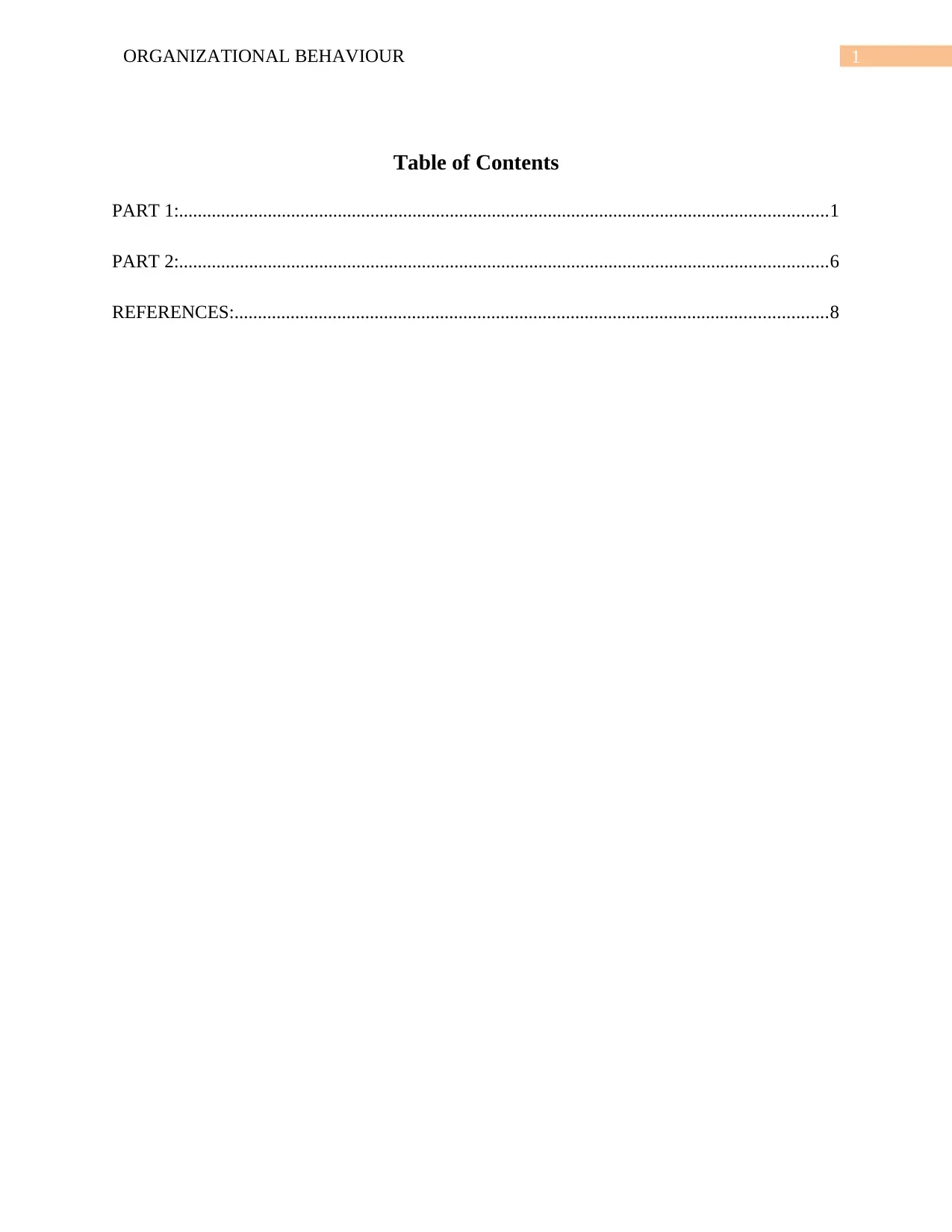
1ORGANIZATIONAL BEHAVIOUR
Table of Contents
PART 1:...........................................................................................................................................1
PART 2:...........................................................................................................................................6
REFERENCES:...............................................................................................................................8
Table of Contents
PART 1:...........................................................................................................................................1
PART 2:...........................................................................................................................................6
REFERENCES:...............................................................................................................................8
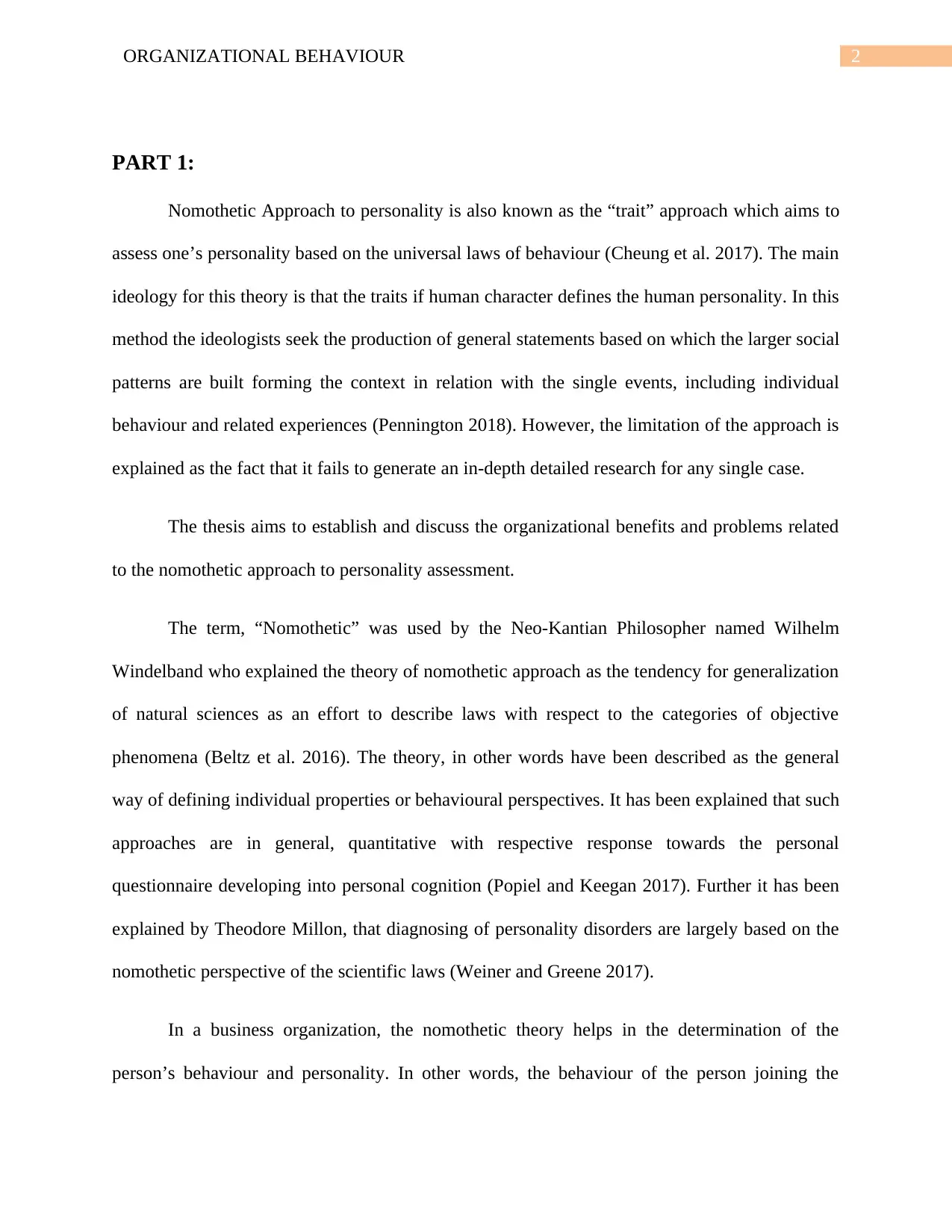
2ORGANIZATIONAL BEHAVIOUR
PART 1:
Nomothetic Approach to personality is also known as the “trait” approach which aims to
assess one’s personality based on the universal laws of behaviour (Cheung et al. 2017). The main
ideology for this theory is that the traits if human character defines the human personality. In this
method the ideologists seek the production of general statements based on which the larger social
patterns are built forming the context in relation with the single events, including individual
behaviour and related experiences (Pennington 2018). However, the limitation of the approach is
explained as the fact that it fails to generate an in-depth detailed research for any single case.
The thesis aims to establish and discuss the organizational benefits and problems related
to the nomothetic approach to personality assessment.
The term, “Nomothetic” was used by the Neo-Kantian Philosopher named Wilhelm
Windelband who explained the theory of nomothetic approach as the tendency for generalization
of natural sciences as an effort to describe laws with respect to the categories of objective
phenomena (Beltz et al. 2016). The theory, in other words have been described as the general
way of defining individual properties or behavioural perspectives. It has been explained that such
approaches are in general, quantitative with respective response towards the personal
questionnaire developing into personal cognition (Popiel and Keegan 2017). Further it has been
explained by Theodore Millon, that diagnosing of personality disorders are largely based on the
nomothetic perspective of the scientific laws (Weiner and Greene 2017).
In a business organization, the nomothetic theory helps in the determination of the
person’s behaviour and personality. In other words, the behaviour of the person joining the
PART 1:
Nomothetic Approach to personality is also known as the “trait” approach which aims to
assess one’s personality based on the universal laws of behaviour (Cheung et al. 2017). The main
ideology for this theory is that the traits if human character defines the human personality. In this
method the ideologists seek the production of general statements based on which the larger social
patterns are built forming the context in relation with the single events, including individual
behaviour and related experiences (Pennington 2018). However, the limitation of the approach is
explained as the fact that it fails to generate an in-depth detailed research for any single case.
The thesis aims to establish and discuss the organizational benefits and problems related
to the nomothetic approach to personality assessment.
The term, “Nomothetic” was used by the Neo-Kantian Philosopher named Wilhelm
Windelband who explained the theory of nomothetic approach as the tendency for generalization
of natural sciences as an effort to describe laws with respect to the categories of objective
phenomena (Beltz et al. 2016). The theory, in other words have been described as the general
way of defining individual properties or behavioural perspectives. It has been explained that such
approaches are in general, quantitative with respective response towards the personal
questionnaire developing into personal cognition (Popiel and Keegan 2017). Further it has been
explained by Theodore Millon, that diagnosing of personality disorders are largely based on the
nomothetic perspective of the scientific laws (Weiner and Greene 2017).
In a business organization, the nomothetic theory helps in the determination of the
person’s behaviour and personality. In other words, the behaviour of the person joining the
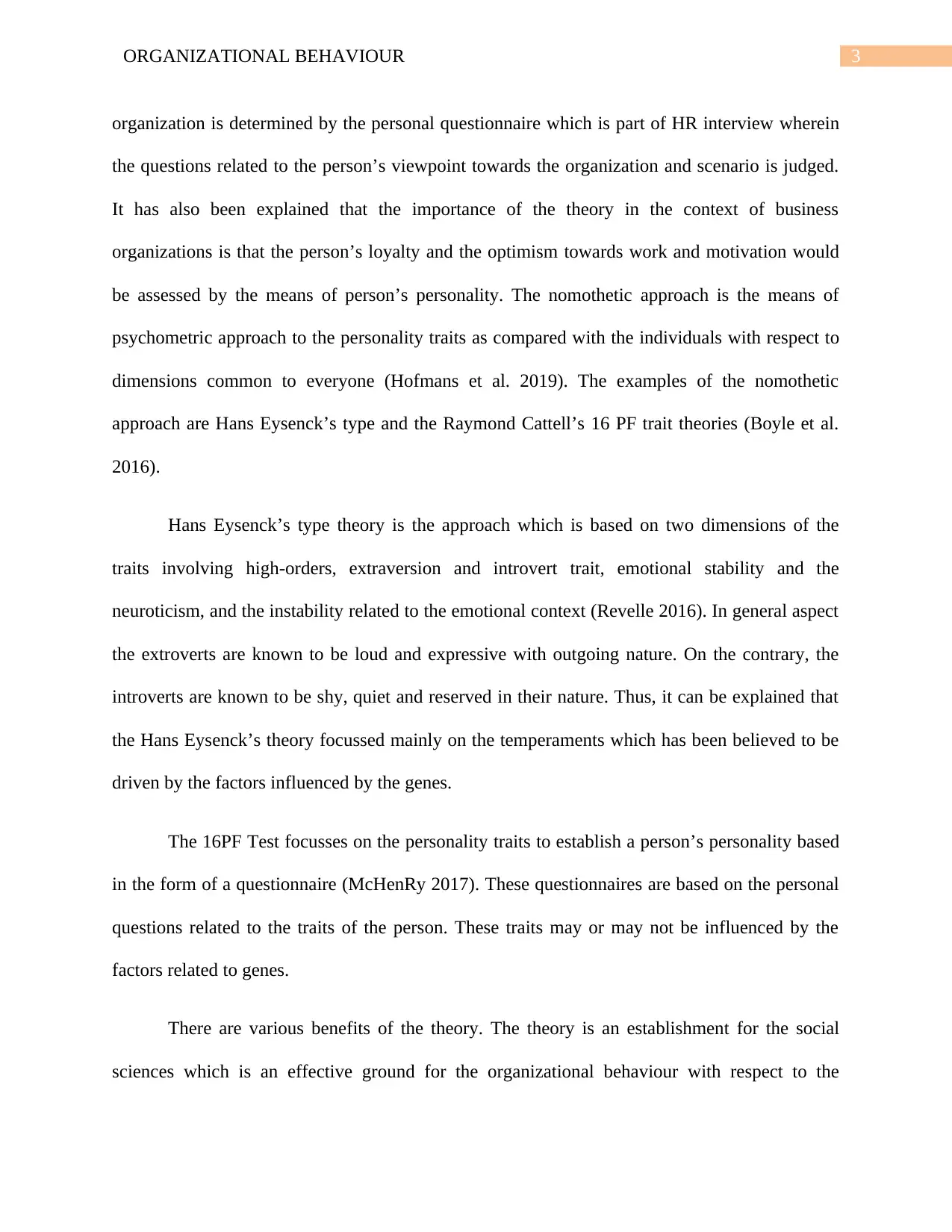
3ORGANIZATIONAL BEHAVIOUR
organization is determined by the personal questionnaire which is part of HR interview wherein
the questions related to the person’s viewpoint towards the organization and scenario is judged.
It has also been explained that the importance of the theory in the context of business
organizations is that the person’s loyalty and the optimism towards work and motivation would
be assessed by the means of person’s personality. The nomothetic approach is the means of
psychometric approach to the personality traits as compared with the individuals with respect to
dimensions common to everyone (Hofmans et al. 2019). The examples of the nomothetic
approach are Hans Eysenck’s type and the Raymond Cattell’s 16 PF trait theories (Boyle et al.
2016).
Hans Eysenck’s type theory is the approach which is based on two dimensions of the
traits involving high-orders, extraversion and introvert trait, emotional stability and the
neuroticism, and the instability related to the emotional context (Revelle 2016). In general aspect
the extroverts are known to be loud and expressive with outgoing nature. On the contrary, the
introverts are known to be shy, quiet and reserved in their nature. Thus, it can be explained that
the Hans Eysenck’s theory focussed mainly on the temperaments which has been believed to be
driven by the factors influenced by the genes.
The 16PF Test focusses on the personality traits to establish a person’s personality based
in the form of a questionnaire (McHenRy 2017). These questionnaires are based on the personal
questions related to the traits of the person. These traits may or may not be influenced by the
factors related to genes.
There are various benefits of the theory. The theory is an establishment for the social
sciences which is an effective ground for the organizational behaviour with respect to the
organization is determined by the personal questionnaire which is part of HR interview wherein
the questions related to the person’s viewpoint towards the organization and scenario is judged.
It has also been explained that the importance of the theory in the context of business
organizations is that the person’s loyalty and the optimism towards work and motivation would
be assessed by the means of person’s personality. The nomothetic approach is the means of
psychometric approach to the personality traits as compared with the individuals with respect to
dimensions common to everyone (Hofmans et al. 2019). The examples of the nomothetic
approach are Hans Eysenck’s type and the Raymond Cattell’s 16 PF trait theories (Boyle et al.
2016).
Hans Eysenck’s type theory is the approach which is based on two dimensions of the
traits involving high-orders, extraversion and introvert trait, emotional stability and the
neuroticism, and the instability related to the emotional context (Revelle 2016). In general aspect
the extroverts are known to be loud and expressive with outgoing nature. On the contrary, the
introverts are known to be shy, quiet and reserved in their nature. Thus, it can be explained that
the Hans Eysenck’s theory focussed mainly on the temperaments which has been believed to be
driven by the factors influenced by the genes.
The 16PF Test focusses on the personality traits to establish a person’s personality based
in the form of a questionnaire (McHenRy 2017). These questionnaires are based on the personal
questions related to the traits of the person. These traits may or may not be influenced by the
factors related to genes.
There are various benefits of the theory. The theory is an establishment for the social
sciences which is an effective ground for the organizational behaviour with respect to the
Paraphrase This Document
Need a fresh take? Get an instant paraphrase of this document with our AI Paraphraser
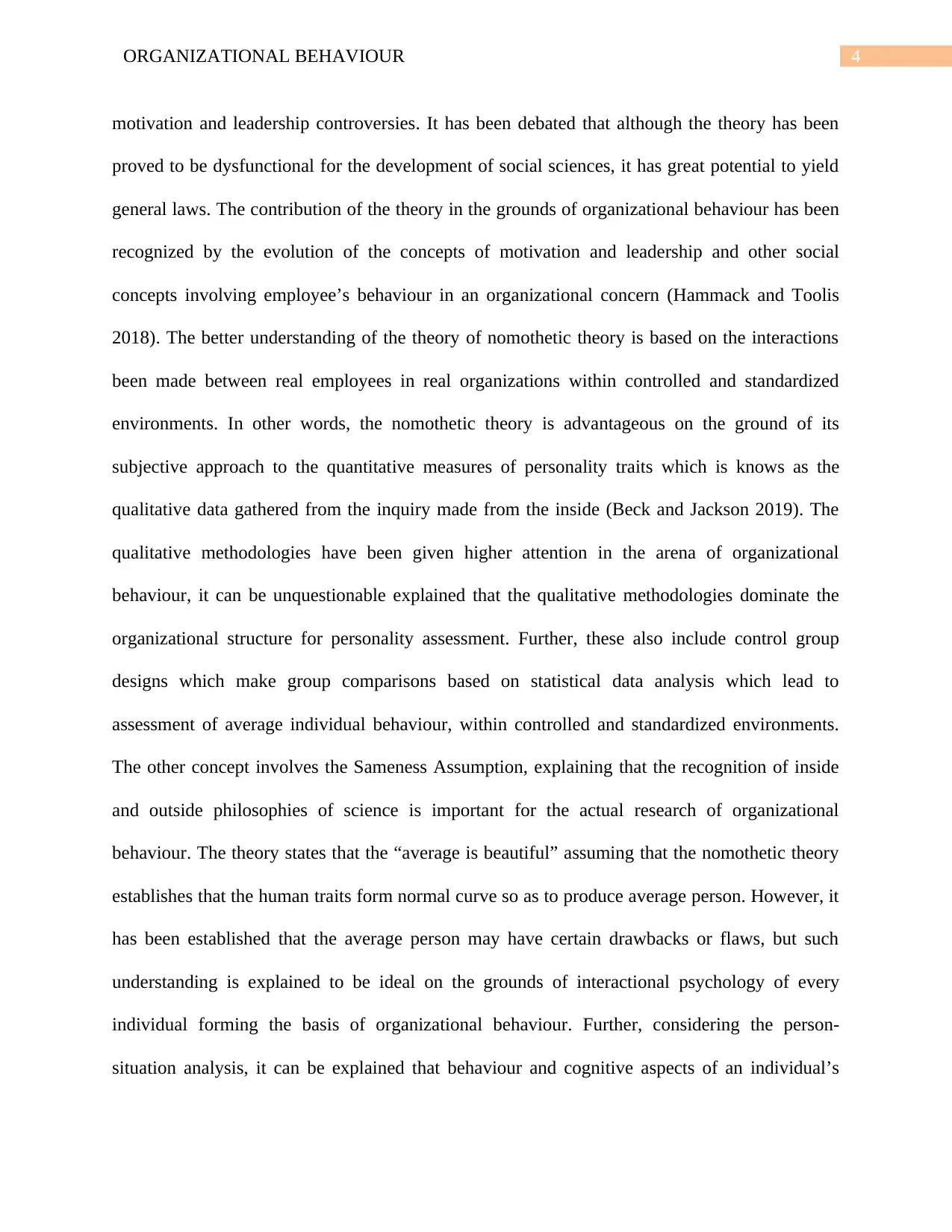
4ORGANIZATIONAL BEHAVIOUR
motivation and leadership controversies. It has been debated that although the theory has been
proved to be dysfunctional for the development of social sciences, it has great potential to yield
general laws. The contribution of the theory in the grounds of organizational behaviour has been
recognized by the evolution of the concepts of motivation and leadership and other social
concepts involving employee’s behaviour in an organizational concern (Hammack and Toolis
2018). The better understanding of the theory of nomothetic theory is based on the interactions
been made between real employees in real organizations within controlled and standardized
environments. In other words, the nomothetic theory is advantageous on the ground of its
subjective approach to the quantitative measures of personality traits which is knows as the
qualitative data gathered from the inquiry made from the inside (Beck and Jackson 2019). The
qualitative methodologies have been given higher attention in the arena of organizational
behaviour, it can be unquestionable explained that the qualitative methodologies dominate the
organizational structure for personality assessment. Further, these also include control group
designs which make group comparisons based on statistical data analysis which lead to
assessment of average individual behaviour, within controlled and standardized environments.
The other concept involves the Sameness Assumption, explaining that the recognition of inside
and outside philosophies of science is important for the actual research of organizational
behaviour. The theory states that the “average is beautiful” assuming that the nomothetic theory
establishes that the human traits form normal curve so as to produce average person. However, it
has been established that the average person may have certain drawbacks or flaws, but such
understanding is explained to be ideal on the grounds of interactional psychology of every
individual forming the basis of organizational behaviour. Further, considering the person-
situation analysis, it can be explained that behaviour and cognitive aspects of an individual’s
motivation and leadership controversies. It has been debated that although the theory has been
proved to be dysfunctional for the development of social sciences, it has great potential to yield
general laws. The contribution of the theory in the grounds of organizational behaviour has been
recognized by the evolution of the concepts of motivation and leadership and other social
concepts involving employee’s behaviour in an organizational concern (Hammack and Toolis
2018). The better understanding of the theory of nomothetic theory is based on the interactions
been made between real employees in real organizations within controlled and standardized
environments. In other words, the nomothetic theory is advantageous on the ground of its
subjective approach to the quantitative measures of personality traits which is knows as the
qualitative data gathered from the inquiry made from the inside (Beck and Jackson 2019). The
qualitative methodologies have been given higher attention in the arena of organizational
behaviour, it can be unquestionable explained that the qualitative methodologies dominate the
organizational structure for personality assessment. Further, these also include control group
designs which make group comparisons based on statistical data analysis which lead to
assessment of average individual behaviour, within controlled and standardized environments.
The other concept involves the Sameness Assumption, explaining that the recognition of inside
and outside philosophies of science is important for the actual research of organizational
behaviour. The theory states that the “average is beautiful” assuming that the nomothetic theory
establishes that the human traits form normal curve so as to produce average person. However, it
has been established that the average person may have certain drawbacks or flaws, but such
understanding is explained to be ideal on the grounds of interactional psychology of every
individual forming the basis of organizational behaviour. Further, considering the person-
situation analysis, it can be explained that behaviour and cognitive aspects of an individual’s
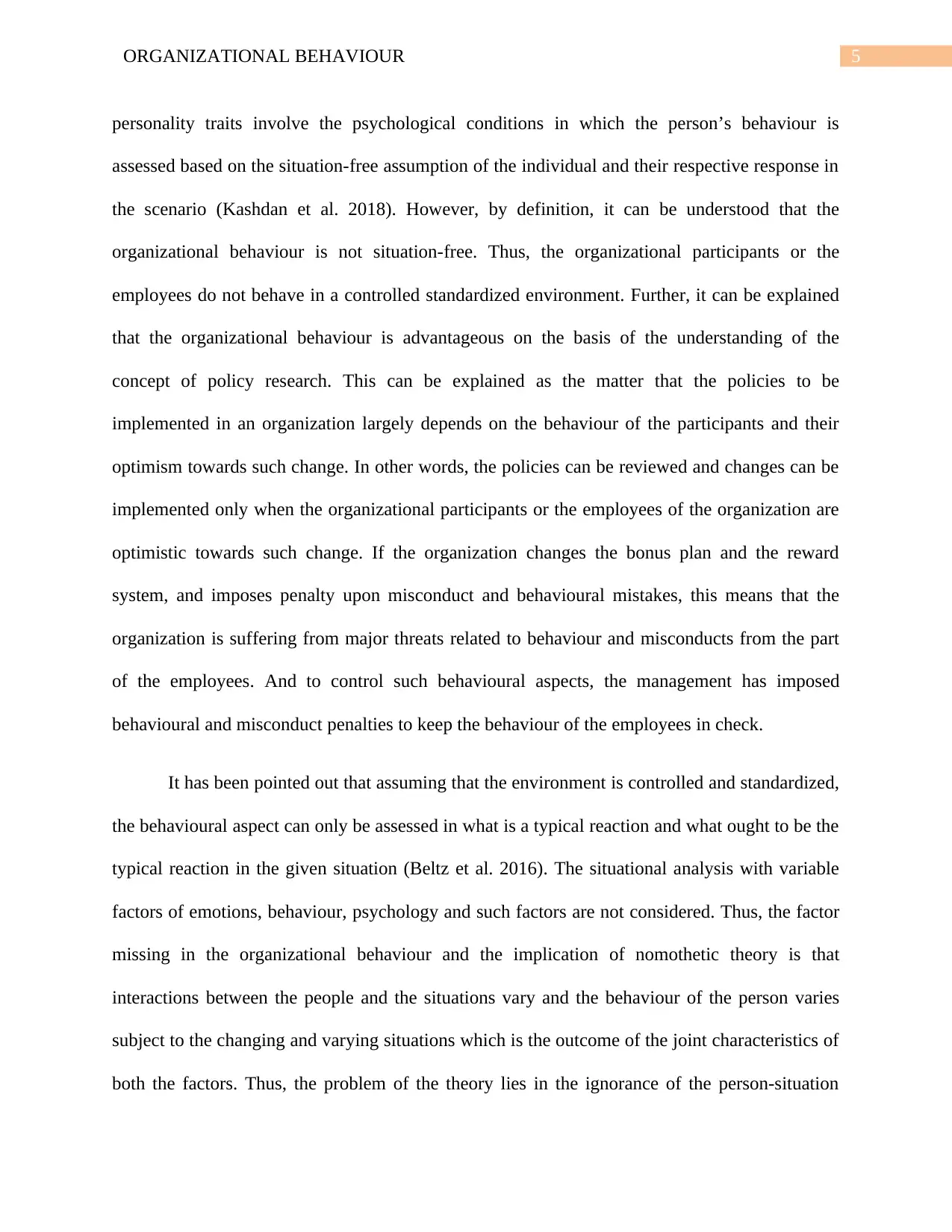
5ORGANIZATIONAL BEHAVIOUR
personality traits involve the psychological conditions in which the person’s behaviour is
assessed based on the situation-free assumption of the individual and their respective response in
the scenario (Kashdan et al. 2018). However, by definition, it can be understood that the
organizational behaviour is not situation-free. Thus, the organizational participants or the
employees do not behave in a controlled standardized environment. Further, it can be explained
that the organizational behaviour is advantageous on the basis of the understanding of the
concept of policy research. This can be explained as the matter that the policies to be
implemented in an organization largely depends on the behaviour of the participants and their
optimism towards such change. In other words, the policies can be reviewed and changes can be
implemented only when the organizational participants or the employees of the organization are
optimistic towards such change. If the organization changes the bonus plan and the reward
system, and imposes penalty upon misconduct and behavioural mistakes, this means that the
organization is suffering from major threats related to behaviour and misconducts from the part
of the employees. And to control such behavioural aspects, the management has imposed
behavioural and misconduct penalties to keep the behaviour of the employees in check.
It has been pointed out that assuming that the environment is controlled and standardized,
the behavioural aspect can only be assessed in what is a typical reaction and what ought to be the
typical reaction in the given situation (Beltz et al. 2016). The situational analysis with variable
factors of emotions, behaviour, psychology and such factors are not considered. Thus, the factor
missing in the organizational behaviour and the implication of nomothetic theory is that
interactions between the people and the situations vary and the behaviour of the person varies
subject to the changing and varying situations which is the outcome of the joint characteristics of
both the factors. Thus, the problem of the theory lies in the ignorance of the person-situation
personality traits involve the psychological conditions in which the person’s behaviour is
assessed based on the situation-free assumption of the individual and their respective response in
the scenario (Kashdan et al. 2018). However, by definition, it can be understood that the
organizational behaviour is not situation-free. Thus, the organizational participants or the
employees do not behave in a controlled standardized environment. Further, it can be explained
that the organizational behaviour is advantageous on the basis of the understanding of the
concept of policy research. This can be explained as the matter that the policies to be
implemented in an organization largely depends on the behaviour of the participants and their
optimism towards such change. In other words, the policies can be reviewed and changes can be
implemented only when the organizational participants or the employees of the organization are
optimistic towards such change. If the organization changes the bonus plan and the reward
system, and imposes penalty upon misconduct and behavioural mistakes, this means that the
organization is suffering from major threats related to behaviour and misconducts from the part
of the employees. And to control such behavioural aspects, the management has imposed
behavioural and misconduct penalties to keep the behaviour of the employees in check.
It has been pointed out that assuming that the environment is controlled and standardized,
the behavioural aspect can only be assessed in what is a typical reaction and what ought to be the
typical reaction in the given situation (Beltz et al. 2016). The situational analysis with variable
factors of emotions, behaviour, psychology and such factors are not considered. Thus, the factor
missing in the organizational behaviour and the implication of nomothetic theory is that
interactions between the people and the situations vary and the behaviour of the person varies
subject to the changing and varying situations which is the outcome of the joint characteristics of
both the factors. Thus, the problem of the theory lies in the ignorance of the person-situation
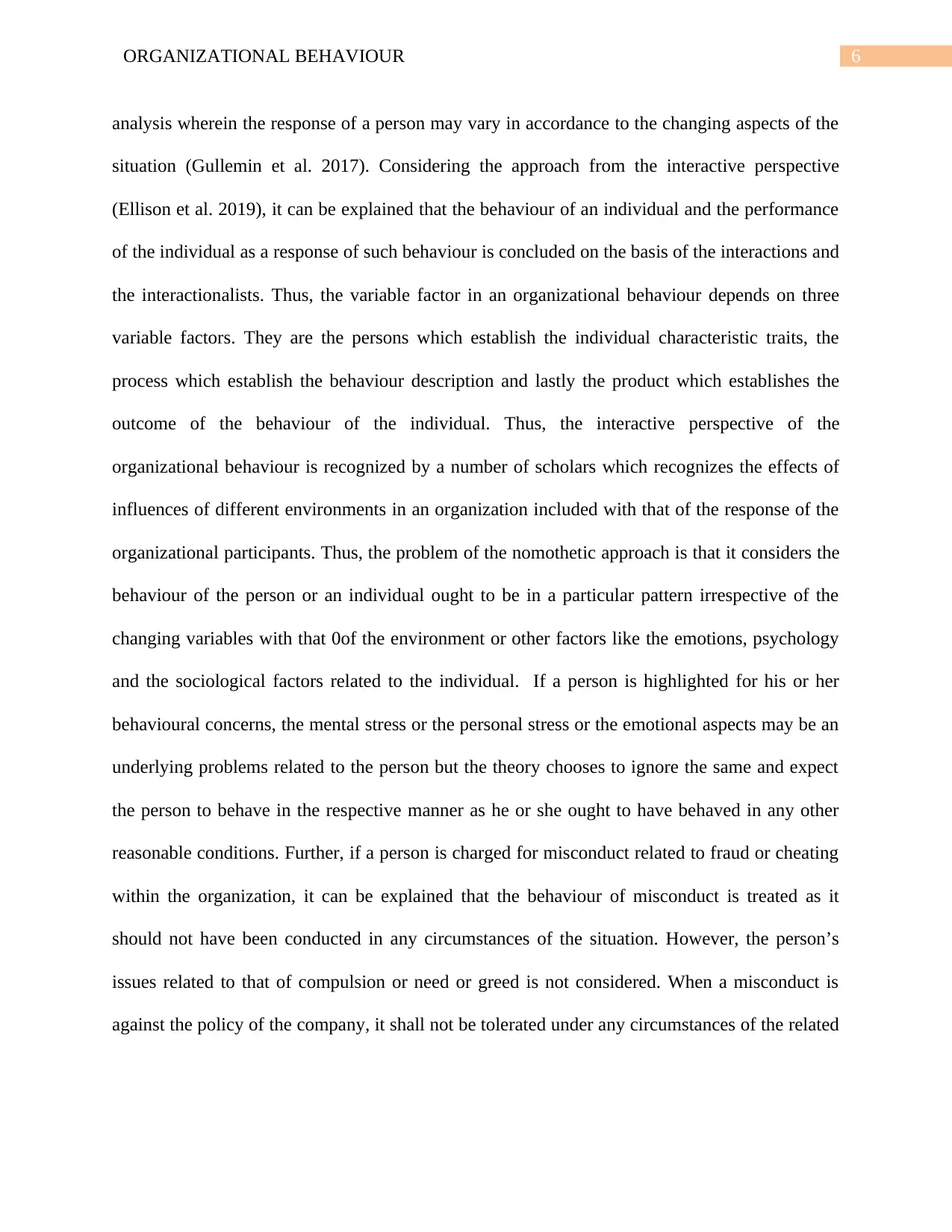
6ORGANIZATIONAL BEHAVIOUR
analysis wherein the response of a person may vary in accordance to the changing aspects of the
situation (Gullemin et al. 2017). Considering the approach from the interactive perspective
(Ellison et al. 2019), it can be explained that the behaviour of an individual and the performance
of the individual as a response of such behaviour is concluded on the basis of the interactions and
the interactionalists. Thus, the variable factor in an organizational behaviour depends on three
variable factors. They are the persons which establish the individual characteristic traits, the
process which establish the behaviour description and lastly the product which establishes the
outcome of the behaviour of the individual. Thus, the interactive perspective of the
organizational behaviour is recognized by a number of scholars which recognizes the effects of
influences of different environments in an organization included with that of the response of the
organizational participants. Thus, the problem of the nomothetic approach is that it considers the
behaviour of the person or an individual ought to be in a particular pattern irrespective of the
changing variables with that 0of the environment or other factors like the emotions, psychology
and the sociological factors related to the individual. If a person is highlighted for his or her
behavioural concerns, the mental stress or the personal stress or the emotional aspects may be an
underlying problems related to the person but the theory chooses to ignore the same and expect
the person to behave in the respective manner as he or she ought to have behaved in any other
reasonable conditions. Further, if a person is charged for misconduct related to fraud or cheating
within the organization, it can be explained that the behaviour of misconduct is treated as it
should not have been conducted in any circumstances of the situation. However, the person’s
issues related to that of compulsion or need or greed is not considered. When a misconduct is
against the policy of the company, it shall not be tolerated under any circumstances of the related
analysis wherein the response of a person may vary in accordance to the changing aspects of the
situation (Gullemin et al. 2017). Considering the approach from the interactive perspective
(Ellison et al. 2019), it can be explained that the behaviour of an individual and the performance
of the individual as a response of such behaviour is concluded on the basis of the interactions and
the interactionalists. Thus, the variable factor in an organizational behaviour depends on three
variable factors. They are the persons which establish the individual characteristic traits, the
process which establish the behaviour description and lastly the product which establishes the
outcome of the behaviour of the individual. Thus, the interactive perspective of the
organizational behaviour is recognized by a number of scholars which recognizes the effects of
influences of different environments in an organization included with that of the response of the
organizational participants. Thus, the problem of the nomothetic approach is that it considers the
behaviour of the person or an individual ought to be in a particular pattern irrespective of the
changing variables with that 0of the environment or other factors like the emotions, psychology
and the sociological factors related to the individual. If a person is highlighted for his or her
behavioural concerns, the mental stress or the personal stress or the emotional aspects may be an
underlying problems related to the person but the theory chooses to ignore the same and expect
the person to behave in the respective manner as he or she ought to have behaved in any other
reasonable conditions. Further, if a person is charged for misconduct related to fraud or cheating
within the organization, it can be explained that the behaviour of misconduct is treated as it
should not have been conducted in any circumstances of the situation. However, the person’s
issues related to that of compulsion or need or greed is not considered. When a misconduct is
against the policy of the company, it shall not be tolerated under any circumstances of the related
Secure Best Marks with AI Grader
Need help grading? Try our AI Grader for instant feedback on your assignments.
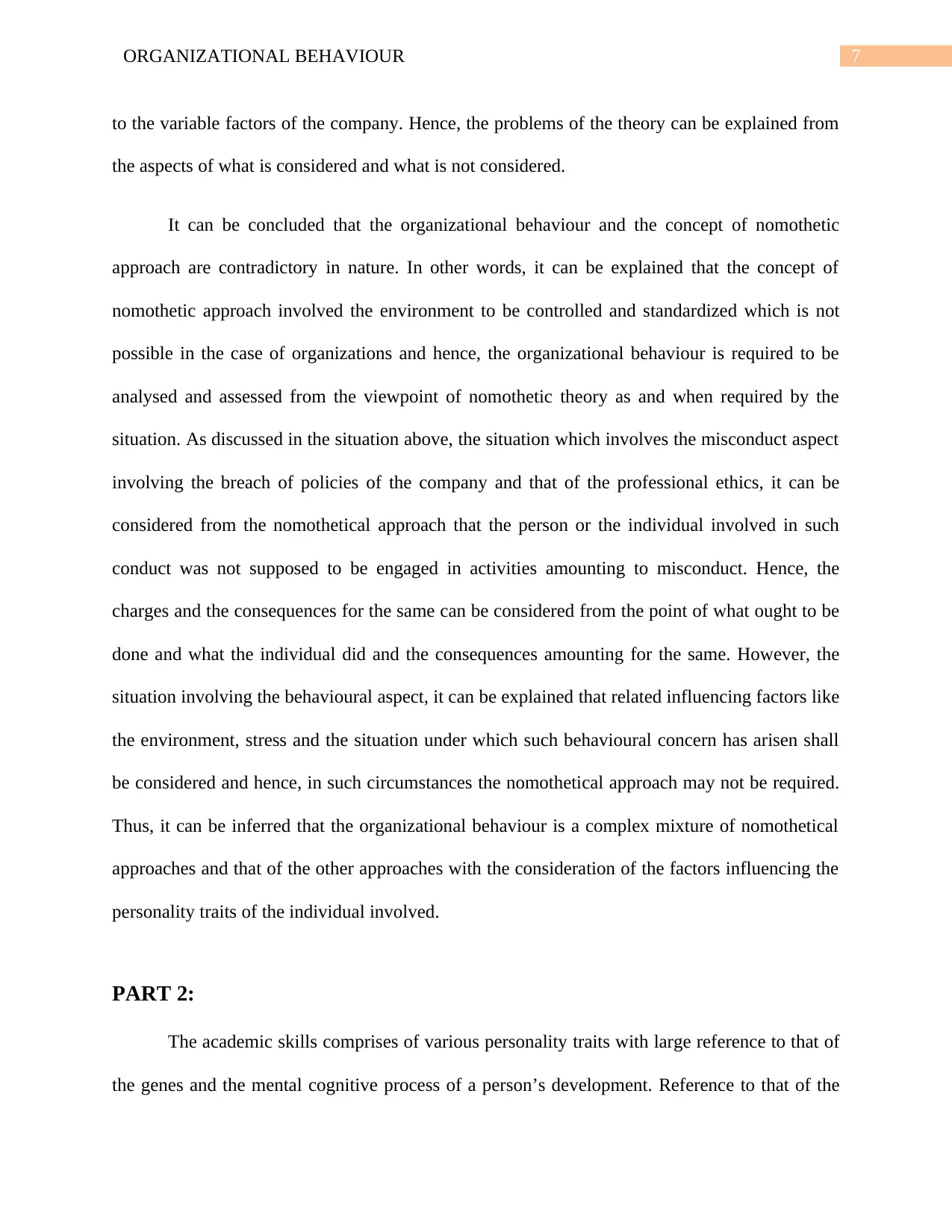
7ORGANIZATIONAL BEHAVIOUR
to the variable factors of the company. Hence, the problems of the theory can be explained from
the aspects of what is considered and what is not considered.
It can be concluded that the organizational behaviour and the concept of nomothetic
approach are contradictory in nature. In other words, it can be explained that the concept of
nomothetic approach involved the environment to be controlled and standardized which is not
possible in the case of organizations and hence, the organizational behaviour is required to be
analysed and assessed from the viewpoint of nomothetic theory as and when required by the
situation. As discussed in the situation above, the situation which involves the misconduct aspect
involving the breach of policies of the company and that of the professional ethics, it can be
considered from the nomothetical approach that the person or the individual involved in such
conduct was not supposed to be engaged in activities amounting to misconduct. Hence, the
charges and the consequences for the same can be considered from the point of what ought to be
done and what the individual did and the consequences amounting for the same. However, the
situation involving the behavioural aspect, it can be explained that related influencing factors like
the environment, stress and the situation under which such behavioural concern has arisen shall
be considered and hence, in such circumstances the nomothetical approach may not be required.
Thus, it can be inferred that the organizational behaviour is a complex mixture of nomothetical
approaches and that of the other approaches with the consideration of the factors influencing the
personality traits of the individual involved.
PART 2:
The academic skills comprises of various personality traits with large reference to that of
the genes and the mental cognitive process of a person’s development. Reference to that of the
to the variable factors of the company. Hence, the problems of the theory can be explained from
the aspects of what is considered and what is not considered.
It can be concluded that the organizational behaviour and the concept of nomothetic
approach are contradictory in nature. In other words, it can be explained that the concept of
nomothetic approach involved the environment to be controlled and standardized which is not
possible in the case of organizations and hence, the organizational behaviour is required to be
analysed and assessed from the viewpoint of nomothetic theory as and when required by the
situation. As discussed in the situation above, the situation which involves the misconduct aspect
involving the breach of policies of the company and that of the professional ethics, it can be
considered from the nomothetical approach that the person or the individual involved in such
conduct was not supposed to be engaged in activities amounting to misconduct. Hence, the
charges and the consequences for the same can be considered from the point of what ought to be
done and what the individual did and the consequences amounting for the same. However, the
situation involving the behavioural aspect, it can be explained that related influencing factors like
the environment, stress and the situation under which such behavioural concern has arisen shall
be considered and hence, in such circumstances the nomothetical approach may not be required.
Thus, it can be inferred that the organizational behaviour is a complex mixture of nomothetical
approaches and that of the other approaches with the consideration of the factors influencing the
personality traits of the individual involved.
PART 2:
The academic skills comprises of various personality traits with large reference to that of
the genes and the mental cognitive process of a person’s development. Reference to that of the
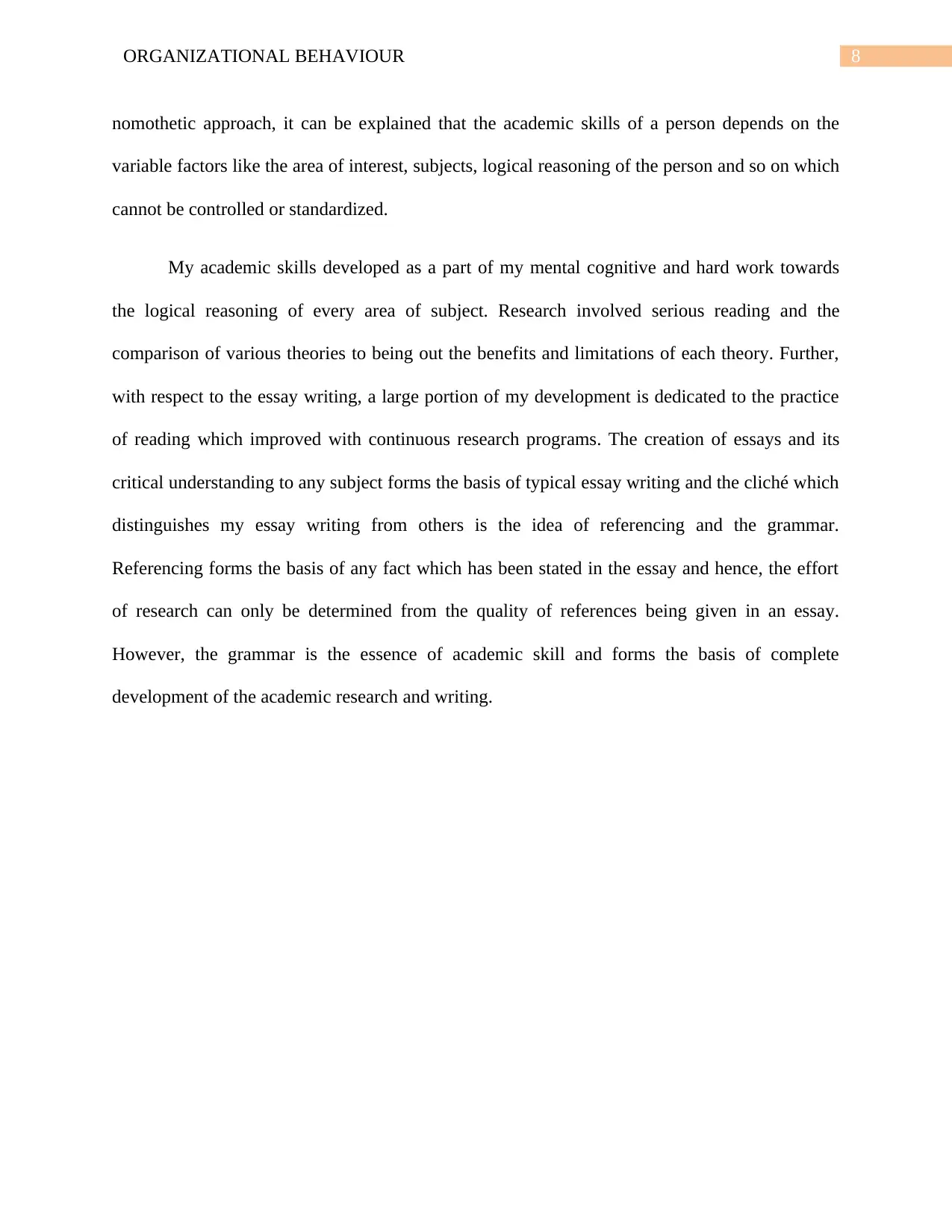
8ORGANIZATIONAL BEHAVIOUR
nomothetic approach, it can be explained that the academic skills of a person depends on the
variable factors like the area of interest, subjects, logical reasoning of the person and so on which
cannot be controlled or standardized.
My academic skills developed as a part of my mental cognitive and hard work towards
the logical reasoning of every area of subject. Research involved serious reading and the
comparison of various theories to being out the benefits and limitations of each theory. Further,
with respect to the essay writing, a large portion of my development is dedicated to the practice
of reading which improved with continuous research programs. The creation of essays and its
critical understanding to any subject forms the basis of typical essay writing and the cliché which
distinguishes my essay writing from others is the idea of referencing and the grammar.
Referencing forms the basis of any fact which has been stated in the essay and hence, the effort
of research can only be determined from the quality of references being given in an essay.
However, the grammar is the essence of academic skill and forms the basis of complete
development of the academic research and writing.
nomothetic approach, it can be explained that the academic skills of a person depends on the
variable factors like the area of interest, subjects, logical reasoning of the person and so on which
cannot be controlled or standardized.
My academic skills developed as a part of my mental cognitive and hard work towards
the logical reasoning of every area of subject. Research involved serious reading and the
comparison of various theories to being out the benefits and limitations of each theory. Further,
with respect to the essay writing, a large portion of my development is dedicated to the practice
of reading which improved with continuous research programs. The creation of essays and its
critical understanding to any subject forms the basis of typical essay writing and the cliché which
distinguishes my essay writing from others is the idea of referencing and the grammar.
Referencing forms the basis of any fact which has been stated in the essay and hence, the effort
of research can only be determined from the quality of references being given in an essay.
However, the grammar is the essence of academic skill and forms the basis of complete
development of the academic research and writing.
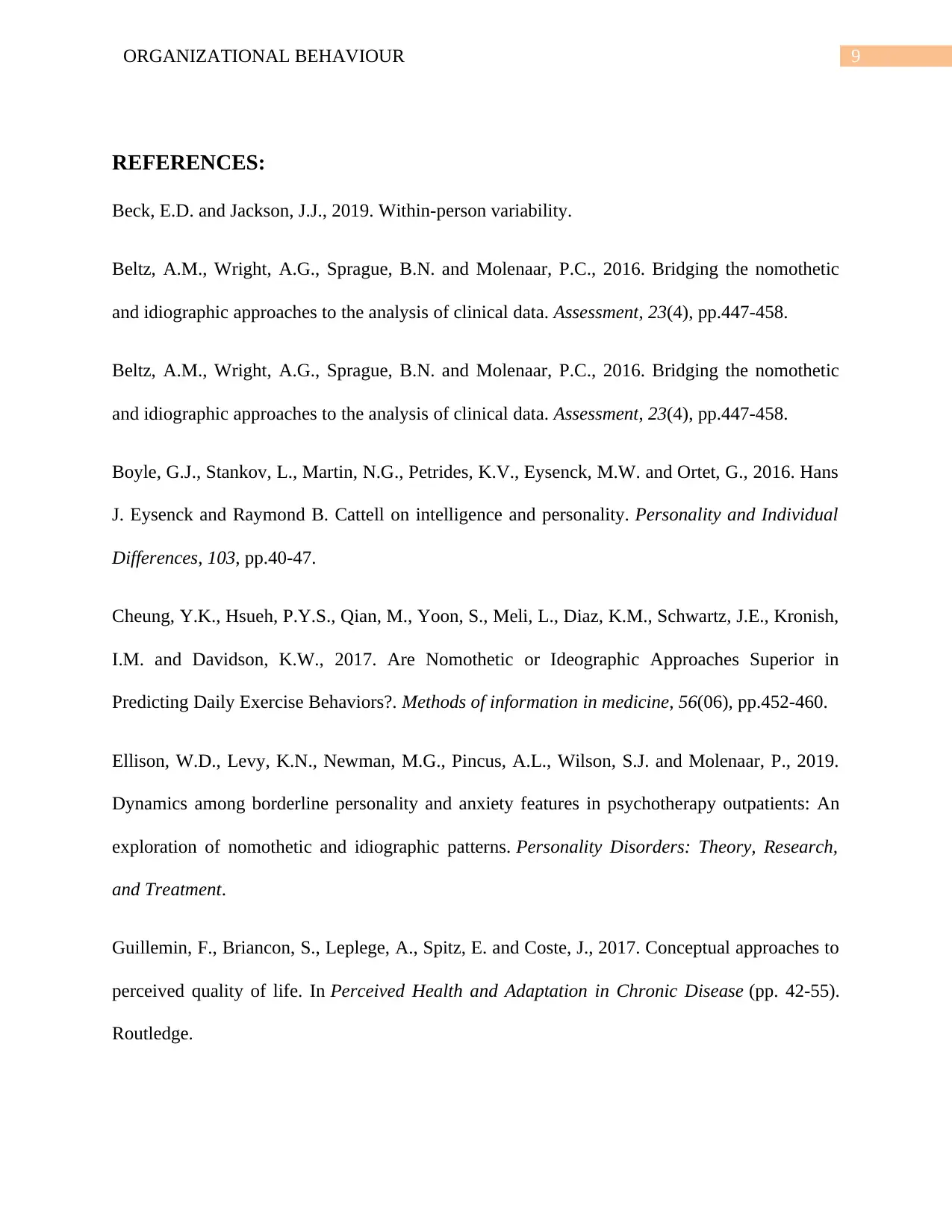
9ORGANIZATIONAL BEHAVIOUR
REFERENCES:
Beck, E.D. and Jackson, J.J., 2019. Within-person variability.
Beltz, A.M., Wright, A.G., Sprague, B.N. and Molenaar, P.C., 2016. Bridging the nomothetic
and idiographic approaches to the analysis of clinical data. Assessment, 23(4), pp.447-458.
Beltz, A.M., Wright, A.G., Sprague, B.N. and Molenaar, P.C., 2016. Bridging the nomothetic
and idiographic approaches to the analysis of clinical data. Assessment, 23(4), pp.447-458.
Boyle, G.J., Stankov, L., Martin, N.G., Petrides, K.V., Eysenck, M.W. and Ortet, G., 2016. Hans
J. Eysenck and Raymond B. Cattell on intelligence and personality. Personality and Individual
Differences, 103, pp.40-47.
Cheung, Y.K., Hsueh, P.Y.S., Qian, M., Yoon, S., Meli, L., Diaz, K.M., Schwartz, J.E., Kronish,
I.M. and Davidson, K.W., 2017. Are Nomothetic or Ideographic Approaches Superior in
Predicting Daily Exercise Behaviors?. Methods of information in medicine, 56(06), pp.452-460.
Ellison, W.D., Levy, K.N., Newman, M.G., Pincus, A.L., Wilson, S.J. and Molenaar, P., 2019.
Dynamics among borderline personality and anxiety features in psychotherapy outpatients: An
exploration of nomothetic and idiographic patterns. Personality Disorders: Theory, Research,
and Treatment.
Guillemin, F., Briancon, S., Leplege, A., Spitz, E. and Coste, J., 2017. Conceptual approaches to
perceived quality of life. In Perceived Health and Adaptation in Chronic Disease (pp. 42-55).
Routledge.
REFERENCES:
Beck, E.D. and Jackson, J.J., 2019. Within-person variability.
Beltz, A.M., Wright, A.G., Sprague, B.N. and Molenaar, P.C., 2016. Bridging the nomothetic
and idiographic approaches to the analysis of clinical data. Assessment, 23(4), pp.447-458.
Beltz, A.M., Wright, A.G., Sprague, B.N. and Molenaar, P.C., 2016. Bridging the nomothetic
and idiographic approaches to the analysis of clinical data. Assessment, 23(4), pp.447-458.
Boyle, G.J., Stankov, L., Martin, N.G., Petrides, K.V., Eysenck, M.W. and Ortet, G., 2016. Hans
J. Eysenck and Raymond B. Cattell on intelligence and personality. Personality and Individual
Differences, 103, pp.40-47.
Cheung, Y.K., Hsueh, P.Y.S., Qian, M., Yoon, S., Meli, L., Diaz, K.M., Schwartz, J.E., Kronish,
I.M. and Davidson, K.W., 2017. Are Nomothetic or Ideographic Approaches Superior in
Predicting Daily Exercise Behaviors?. Methods of information in medicine, 56(06), pp.452-460.
Ellison, W.D., Levy, K.N., Newman, M.G., Pincus, A.L., Wilson, S.J. and Molenaar, P., 2019.
Dynamics among borderline personality and anxiety features in psychotherapy outpatients: An
exploration of nomothetic and idiographic patterns. Personality Disorders: Theory, Research,
and Treatment.
Guillemin, F., Briancon, S., Leplege, A., Spitz, E. and Coste, J., 2017. Conceptual approaches to
perceived quality of life. In Perceived Health and Adaptation in Chronic Disease (pp. 42-55).
Routledge.
Paraphrase This Document
Need a fresh take? Get an instant paraphrase of this document with our AI Paraphraser
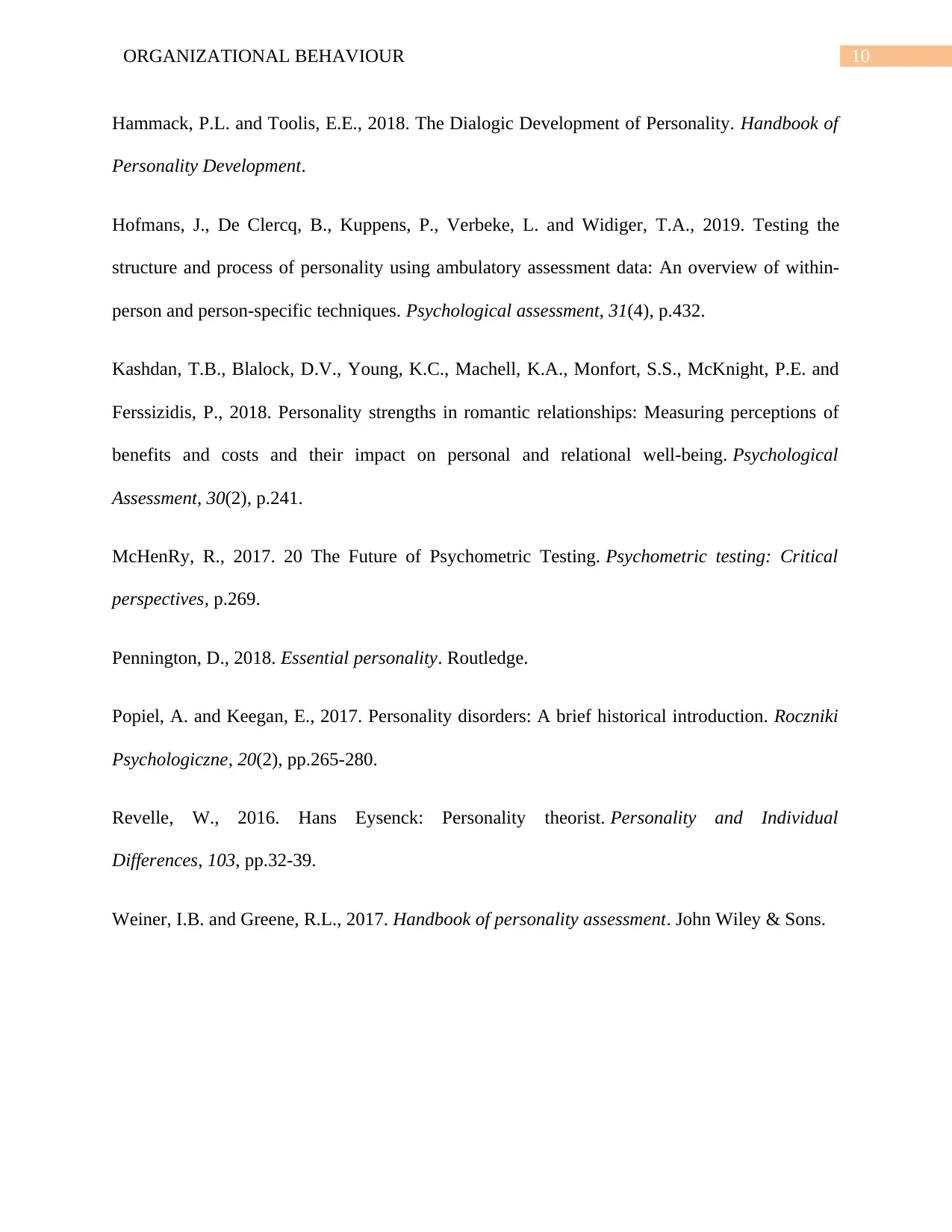
10ORGANIZATIONAL BEHAVIOUR
Hammack, P.L. and Toolis, E.E., 2018. The Dialogic Development of Personality. Handbook of
Personality Development.
Hofmans, J., De Clercq, B., Kuppens, P., Verbeke, L. and Widiger, T.A., 2019. Testing the
structure and process of personality using ambulatory assessment data: An overview of within-
person and person-specific techniques. Psychological assessment, 31(4), p.432.
Kashdan, T.B., Blalock, D.V., Young, K.C., Machell, K.A., Monfort, S.S., McKnight, P.E. and
Ferssizidis, P., 2018. Personality strengths in romantic relationships: Measuring perceptions of
benefits and costs and their impact on personal and relational well-being. Psychological
Assessment, 30(2), p.241.
McHenRy, R., 2017. 20 The Future of Psychometric Testing. Psychometric testing: Critical
perspectives, p.269.
Pennington, D., 2018. Essential personality. Routledge.
Popiel, A. and Keegan, E., 2017. Personality disorders: A brief historical introduction. Roczniki
Psychologiczne, 20(2), pp.265-280.
Revelle, W., 2016. Hans Eysenck: Personality theorist. Personality and Individual
Differences, 103, pp.32-39.
Weiner, I.B. and Greene, R.L., 2017. Handbook of personality assessment. John Wiley & Sons.
Hammack, P.L. and Toolis, E.E., 2018. The Dialogic Development of Personality. Handbook of
Personality Development.
Hofmans, J., De Clercq, B., Kuppens, P., Verbeke, L. and Widiger, T.A., 2019. Testing the
structure and process of personality using ambulatory assessment data: An overview of within-
person and person-specific techniques. Psychological assessment, 31(4), p.432.
Kashdan, T.B., Blalock, D.V., Young, K.C., Machell, K.A., Monfort, S.S., McKnight, P.E. and
Ferssizidis, P., 2018. Personality strengths in romantic relationships: Measuring perceptions of
benefits and costs and their impact on personal and relational well-being. Psychological
Assessment, 30(2), p.241.
McHenRy, R., 2017. 20 The Future of Psychometric Testing. Psychometric testing: Critical
perspectives, p.269.
Pennington, D., 2018. Essential personality. Routledge.
Popiel, A. and Keegan, E., 2017. Personality disorders: A brief historical introduction. Roczniki
Psychologiczne, 20(2), pp.265-280.
Revelle, W., 2016. Hans Eysenck: Personality theorist. Personality and Individual
Differences, 103, pp.32-39.
Weiner, I.B. and Greene, R.L., 2017. Handbook of personality assessment. John Wiley & Sons.
1 out of 11
![[object Object]](/_next/static/media/star-bottom.7253800d.svg)




